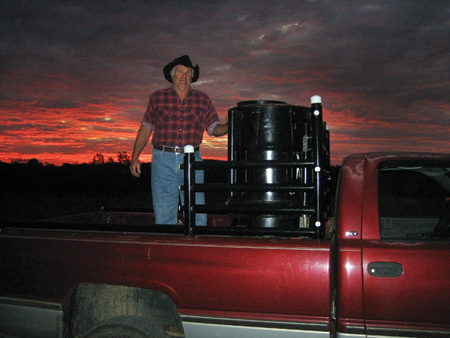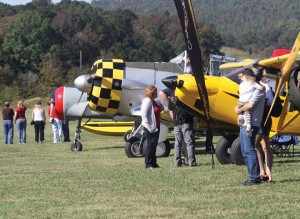Terry & Sandy Gamble, Robert Hood help
Alpha Ranch rebuild after April’s deadly tornadoes
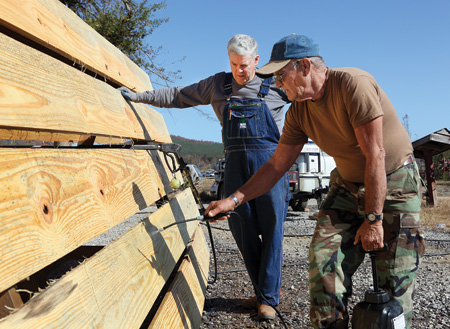 By Elaine Hobson Miller
By Elaine Hobson Miller
Photos by Jerry Martin
“Hear that wind coming down the valley?” asks Sandy Gamble, turning her left ear toward the door, which sounds like it’s about to rattle off its hinges. She laughs nervously. “Yeah, it’s scary. There are no trees now to block it.”
Sitting in a folding metal chair in Alpha Ranch’s new shop building, she glances at the door and windows, as if expecting that wind to pick up the shop and carry it away. It wouldn’t be the first time. It happened April 27, when tornadoes tore through Shoal Creek Valley, destroying almost everything in their path.
Sandy and her husband, Terry, live in the Clay-Trussville area normally. But nothing has been normal for them since the storms. On May 23, they parked their 26-foot travel trailer at Alpha Ranch on County Road 22, better known as Shoal Creek Road. Volunteers extraordinaire, they have devoted themselves to rebuilding the ranch and helping Gary and Phyllis Liverett rebuild their lives.
They came out to Alpha Ranch with Bridgepoint Community Church (Clay-Chalkville) a few days after the April storms. Their congregation put in half a day helping with the cleanup. “We came home that day crying, saying we can do more than just half a day with the church,” Sandy says.
The Gambles met the Liveretts more than 20 years ago, when they worked together at Bridgepoint’s Camp Chula Vista. They had kept in touch, so the Gambles thought about the Liveretts when the storms hit. “We moved here to help clear debris and for her to cook and for me to work,” says Terry, taking a puff from his cigarillo.
After the tornadoes, nothing remained of the original 120-by-40-foot shop building but the concrete slab. Used to teach trades such as auto repair, carpentry and electrical wiring to the at-risk teenage boys who live at Alpha, its reconstruction was a priority so the Liveretts could store materials and machinery while rebuilding the ranch. Once the shop was 85 percent complete, most volunteers had gone home. Only the Gambles and Robert Hood, an Odenville man who has worked alongside them, remained.
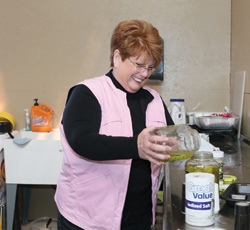 “Robert and I did all the finish work,” Terry explains, while keeping a watchful eye on his 28-month-old grandson, Hayden, who is running around in miniature overalls asking grandpa to kiss his boo-boos. “We built the work benches, the cabinets, the roof and walls, did the electrical work and the plumbing.”
“Robert and I did all the finish work,” Terry explains, while keeping a watchful eye on his 28-month-old grandson, Hayden, who is running around in miniature overalls asking grandpa to kiss his boo-boos. “We built the work benches, the cabinets, the roof and walls, did the electrical work and the plumbing.”
With the shop almost complete, attention has turned to rebuilding the two homes destroyed by the tornadoes. One will be occupied by the Crawfords (daughter, son-in-law and nine grandchildren of the Liveretts) and the other by Phyllis and Gary. Maybe the houses will be complete by Christmas, maybe not.
Two years ago, Terry retired from Norfolk Southern Railway and the Army Reserves, two positions he held simultaneously for 36 years. He was deployed five out of the final 10 years of reserve duty, serving in the first Gulf War, in Afghanistan, Iraq, the Horn of Africa and Bosnia. His job was humanitarian assistance, rebuilding roads, schools and churches that had been destroyed by war. He had seen plenty of destruction, yet none of that prepared him for what he found in Shoal Creek Valley after the April storms.
“I was shocked at the devastation, but more shocked at the attitudes of the people out here,” Terry says. “These people lost everything, yet you did not see them down. They just took things day by day.”
Sandy often cooked breakfast for 50 and lunch for 150 workers and valley residents. At first, she and Terry bought the food, then donations started coming in. “One Saturday we didn’t have any food, and a pipe workers’ union pulled up with barbecue and baked beans,” she says. “We never ran out of food. We couldn’t keep water, Gatorade and ice, though. People were drinking four to six bottles a day during the hot summer. Hardin’s Chapel kept us supplied. I bet they bought 20,000 bottles of water.”
Cooking for hundreds of people and building a shop isn’t exactly what the Gambles had planned for their leisure years. They spent the first year of Terry’s retirement traveling the world, aided by Terry’s “space available” status on military flights. They were accustomed to helping people in need, giving money here, a spare bedroom there, but had never encountered the overwhelming needs they found in Shoal Creek Valley. “What got to me was the sentimental things I saw in the lake after the storms, like the teddy bears and the sofa and the dormers to the Liverett house,” Sandy says.
 Terry has a brand-new bass boat that didn’t see water all summer, and he is building a street rod that he hasn’t touched in months. He has reduced his work load to three days a week, however, and manages to get in a little hunting.
Terry has a brand-new bass boat that didn’t see water all summer, and he is building a street rod that he hasn’t touched in months. He has reduced his work load to three days a week, however, and manages to get in a little hunting.
So, what are the Gambles taking away from this experience?
“We thought we were going to be blessing other people out here, but we’ve received the blessings,” says Sandy, a retired school teacher. “I had surgery on my hand in October, and I was homesick for this place.”
Terry appreciates his new friendship with fellow volunteer, Robert Hood. After school started, most of the other volunteers went home, but the Gambles and Hood remained. “I never knew Robert before all this, but I’ve enjoyed working with him immensely,” Terry says. “Gary will make a list and Robert and I will go down it, checking off as we get something done. We work well together.”
Like the Gambles, Hood thought he would put in a few days at the Ranch, then return to his normal routine. “Extreme Ministries (a Pell City-based organization that mobilizes volunteers for construction-related projects) sent out an email through our church (First Baptist of Pell City) asking for volunteers for three weeks,” Hood says. “I said I would work three days, Monday through Wednesday, for those three weeks. The need was so great, after one day I realized that wasn’t going to be enough.”
Hood says he could find plenty to do at his house, such as picking up limbs and raking leaves, but in Shoal Creek, he gets a sense of satisfaction knowing he’s giving something back to the community.
A retired plant manager for O’Neal Steel, he is accustomed to volunteering, though. For eight years he put in 2,000 hours a year as a certified reserve deputy sheriff for St. Clair County. He gave that up in 2008 when congestive heart failure made it difficult to wrestle detainees to the ground. He had never wielded a hammer much or installed a toilet before his stretch at Alpha.
“Now I’ve done roofing, plumbing, wiring, carpentry, I’ve set trusses, whatever needed to be done,” he says. “But I tell people I just come out here for the lunches.”
Neither the Gambles nor Hood know when their lives will regain a sense of normalcy. “We’ll go home for Christmas, but we won’t go home permanently until the Lord tells us to,” Sandy Gamble says.
“How much longer will I be here? My wife wants to know, too,” says Hood.
“She has no problem with it, though. Since the latter part of September, I’ve cut back to three days. I volunteer two days a week for the county, filing papers at the courthouses in Ashville and Pell City.”
Ann Bobo, Terry’s first cousin and fellow church member, says the Gambles always have been very giving, very kind people who love to do things for others.
“They are always willing to help somebody out, but privately so that they don’t get any accolades for it,” she says.
Gary Liverett can’t say enough good things about Hood and the Gambles.
“Terry and Sandy have such heart. Sandy has helped feed people up and down the valley. They are a good example of what real volunteerism is,” he states. “Most people have gone back home. They’ve sacrificed and stayed.”
He never knew Hood until he came out with Extreme Ministries. “He has worked constantly and tirelessly; he, too, is the epitome of volunteerism,” Liverett said.
 By Amanda Pritchard
By Amanda Pritchard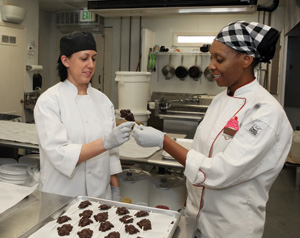 Making it a mission to bring new experiences to candy lovers, young and old, Indie Candy Public Relations Director Beth Norris said, “Watching kids come in and eat their first piece of chocolate is out of control. Women come in all the time who haven’t been able to have candy and ask which section can they have. When we say all of it, they get so excited.”
Making it a mission to bring new experiences to candy lovers, young and old, Indie Candy Public Relations Director Beth Norris said, “Watching kids come in and eat their first piece of chocolate is out of control. Women come in all the time who haven’t been able to have candy and ask which section can they have. When we say all of it, they get so excited.”










